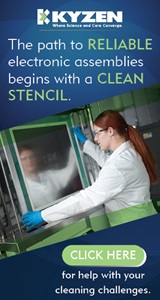|

|
|
| Ask the Experts | |||||||
|
|||||||
|
December 17, 2025 - Updated January 15, 2014 - Originally Posted Blow Holes and Disturbed JointsWe are finding many blow holes and disturbed joints after reflow. Our PCB is 1.7 mm thick and baked prior to reflow at 120 C for 6 hours. The process is non RoHS. Peak temp for reflow is 220 C. What could be going wrong? P.P. |
|||||||
| Expert Panel Responses | |||||||
|
It is hard to diagnose a reflow problem without seeing a profile, but I would suspect that the heating rate during the early part of the profile is too high.
Manager, Process Technology BTU International Mr. Dimock is the manager of Process Technology at BTU International. His extensive experience in thermal processing includes positions at Corning, GE, and Sylvania. He has authored numerous articles on lead free processing and process control, taught classes at SMTAI, and participated in the IPC Reflow Oven Process Control Standard committee.
In the case of multilayer PCBs it is unlikely that moisture trapped deep within the boards will be fully released. Baking schemes such as yours are generally effective for latent moisture only around the PCB edges. Factors regarding moisture mitigation and elimination have been considered through committee at the IPC and include:
President Circuit Connect, Inc. Bob has been in PCB design and fabrication since 1976. He has held elected positions with the SMTA, is a member of the MSD Council, has served as a committee member for various IPC standards and is a Certified IPC Trainer.
Interesting question. It is not identified where and when the boards were baked, be it either prior to solder paste deposition and component installation or after the paste deposition and component placement. Also not included in the question is the paste type used,although it mentioned that it is a no RoHS paste, the thermal profile used and the type of reflow system used. Hence, with this lack of information I offer three concerns to be reviewed.
Vice President, Technical Director EPTAC Corporation At EPTAC Corporation, Mr. Lambert oversees content of course offerings, IPC Certification programs and provides customers with expert consultation in electronics manufacturing, including RoHS/WEEE and lead free issues. Leo is also the IPC General Chairman for the Assembly/Joining Process Committee.
Have you verified the correct copper plating thickness by cross section?
President S T and S Testing and Analysis Gerald O'Brien is Chairman of ANSI J-STD 003, and Co Chairman of IPC 4-14 Surface Finish Plating Committee. He is a key member of ANSI J-STD 002 and 311 G Committees Expert in Surface finish, Solderability issues and Failure analysis in the PWA, PWB and component fields.
This issue can be caused by a lot of parameters. I do not recommend to change them all but you can look at:
Engineering and Operations Management Independent Consultant Georgian Simion is an independent consultant with 20+ years in electronics manufacturing engineering and operations.
Contact me at georgiansimion@yahoo.com. Reader Comment
The root cause is the violation of the Time/Temperature ratio. Age old. There is not enough time at preheating temperature to drive out the solvents. Everything else branches out from there. Once the joint is at or past solidus the vapors are still outgassing hence the blow holes and joint distortion.
Ike Sedberry, ISEDS
Bob Lazzara is probably closest to the correct answer; bake the boards per IPC-1601 by taking one PWB fresh from its packaging, let it sit out for a day to absorb its natural weight in moisture content from humidity. Then measure its weight on a precision scale and record the weight, put it in an oven and bake for 30 minutes at 105 deg. C, then quickly take it out, weigh it again, record, then pop it back in the oven, and repeat this process for about 8 to 10 hours. After 8 hours your data curve will indicate that very little additional moisture is being removed for over time. At the point in time where you have removed at least 80% of the saturated moisture content, that is the required bake time for that particular PWB. Then bake several of the boards for that length of time, take them out one at a time, let them cool to room temp (but no longer), print the paste, place the parts and get the board into reflow all within 2 or 3 hours. If you cannot process all of the boards within the maximum bake time, remove them from the oven and either place them in a drybox (DR Storage brand is best) or temporarily drypak them. Just don't let them sit out exposed to humidity, as they will re-absorb 80& of their saturated moisture content within 4-5 hours at 55% RH. If this fixes the problem, then you know it was not a design issue. All of the steps I have noted here are detailed in IPC-1601, which today is a New York Times bestseller! Get a copy and stop all of that rework and touchup. Good luck!
Advanced Engineer/Scientist General Dynamics Richard D. Stadem is an advanced engineer/scientist for General Dynamics and is also a consulting engineer for other companies. He has 38 years of engineering experience having worked for Honeywell, ADC, Pemstar (now Benchmark), Analog Technologies, and General Dynamics.
|
|||||||
| Submit A Comment | |||||||
|
Comments are reviewed prior to posting. You must include your full name to have your comments posted. We will not post your email address. |
|
Free Newsletter Subscription
Circuitnet is built for professionals who bear the responsibility of looking ahead, imagining the future, and preparing for it. Insert Your Email Address |
|

|






